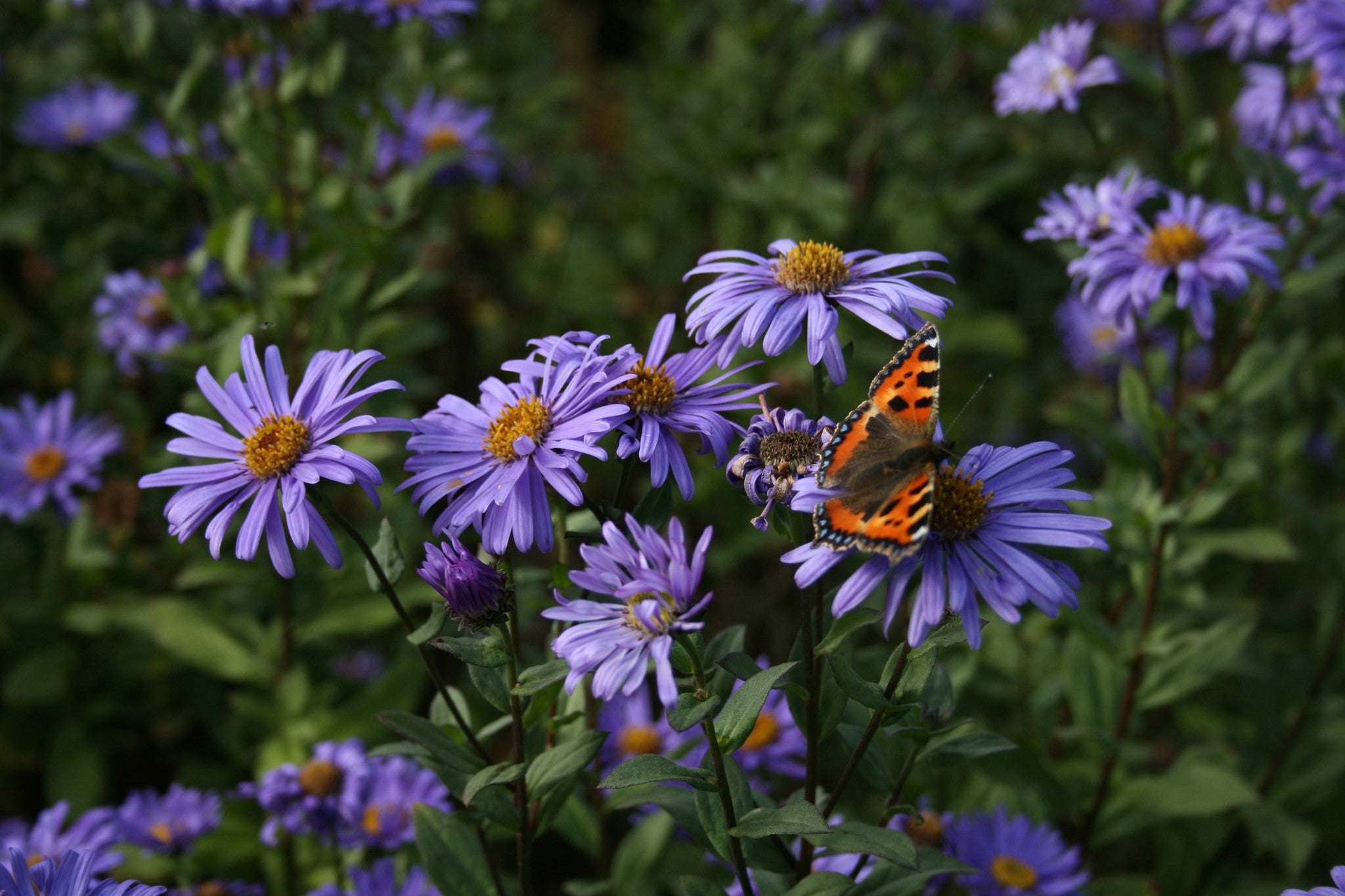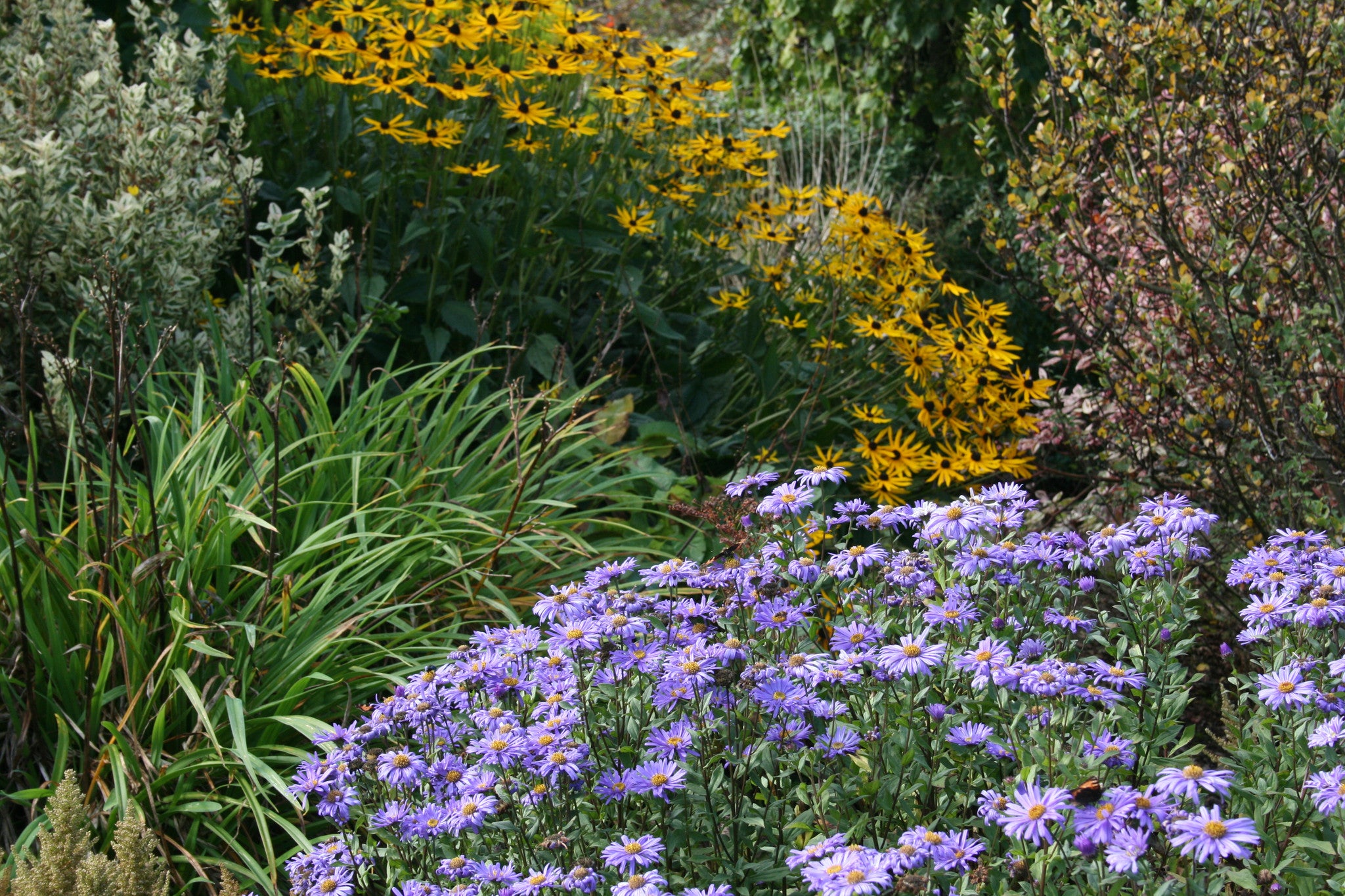Aster x frikartii 'Jungfrau'
Approx. 0.5 litre pot
About this cultivar:
Aster × frikartii 'Jungrau' flowers from July until October. It has large, lilac-purple flowers with slender, linear petals plus attractive, dark-green foliage.The x frikartii species which is always a late-summer delight and its elegance and longevity have prompted admiration from our best plantsmen.
The story of A. x frikartii goes back more than 100 years and is an interesting one. A shorter growing, longer flowering Himalayan species, Aster thomsonii, had just been introduced into England, and Rev Charles Wolley-Dod, a clergyman x plantsman hybrid (get it?), had the idea of crossing it with the taller, short-flowering Italian Aster amellus which had been growing in the British Isles for three centuries.
Wolley-Dod raised seedlings which he exhibited to the Royal Horticultural Society in 1892. However nothing was heard of these seedlings since then.
Happily, a Swiss plantsman called Frikart made the same cross at his nursery at Stafa, and by 1918 had raised three new cultivars, naming them after Swiss Mountains: 'Mönch', 'Eiger' and 'Jungfrau'. Jungfrau' and 'Eiger' are good, rich lilacs/purples - the only noticeable difference being that 'Jungfrau' is more compact (2 feet versus 2.5 feet tall) and floriferous. 'Monch' is a paler lavender. In 1924 a fourth was added, 'Wunder von Stäfa' which is a shorter version of 'Monch'.
- Position: Full sun, partial shade
- Soil: Almost any soil - grows well in Ballyrobert!
-
Flowers: July, August, September October
- Other features:
- Hardiness: Fully hardy - grows well in Ballyrobert!
- Habit: Bushy, Clump forming
- Foliage: Deciduous
- Height: 30 - 60 cm (1 - 2 ft)
- Spread: 30 - 60 cm (1 - 2 ft)
- Time to full growth: 2 to 5 years
- Plant type: Herbaceous Perennial
- Colour: Blue, purple, yellow, green
-
Goes well with: Early flowering plants (like Lupins, Delphiniums and Papaver) in order to keep interest in that area once the earlier flowering plant has faded. However they also pair well with flowers such as Amsonia, Aolidago, Rudbekia, Helenium, Helianthus, and grasses such as Stipa. We have also experimented with Sedum, Astrantia and even Crocosmia.
About this genus:
Aster is Greek for star and, because they flower late in the season, Asters are the garden equivalent of the stars that come out late at night. As wonderful herbaceous perennials that tend to flower in the cooler colours of blue, pink, purple, and even white they can lend a different feel to the traditional bright, rich, red-yellow-orange colours of late summer and autumn. At a time when other plants of similar colours are dying back Asters can be guaranteed to provide a another blast of colour. Another reason they offer more than the average plant because their attractive buds are a feature long before they begin to flower. Oh, AND they make good cut flowers. Keep them cool and they can last over two weeks in a vase.
Asters can grow in almost any soil and situation although most do best in full sun and some species like Aster divaricatus like shade. Many Asters can tolerate drought much better than wet. At Ballyrobert their flowers always seem to be teeming with butterflies and other creepy crawlies – perhaps because they are one of the few flowering plants around late in the season.
You may hear that Aster novae-angliae ( New England asters) and Aster novi-belgii ( New York asters) will suffer from leaf drop and mildew in dry conditions. In our garden, this has rarely been the case even with cultivars with didn't think are good enough to keep or sell. I suspect people just copy-and-paste from gardening books originating in dryer areas of the world such as Kent and parts of America- in our part of the world I doubt we'll ever have the same drought issues!
We also never have any problems with staking, which always seems to be mentioned regarding Aster; perhaps because we tend to plant them close to or through other plants that lend them some support.
We think every garden should have space for Aster – they can be used in a variety of ways. Commonly they are put beside early flowering plants (like Lupins, Delphiniums and Papaver) in order to keep interest in that area once the earlier flowering plant has faded. However they also pair well with flowers such as Amsonia, Aolidago, Rudbekia, Helenium, Helianthus, and grasses such as Stipa. We have also experimented with Sedum, Astrantia and even Crocosmia (see photos).
Paul’s Odd Opinion: Many of the blue Asters have a neon electric-blue glow at night that reminds me of the Miami Vice TV show (I am working on a good photo to show this – in the meantime look at the logo!).








